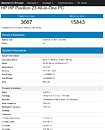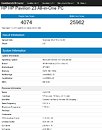Tuesday, November 19th 2019

Benchmarks Surface on Intel's Next-Gen Comet Lake-S 10-Core, 6-Core CPUs
Benchmarks have been uploaded to popular benchmarking utility Geekbench's servers, and they seemingly allow us to look into Intel's next-gen Comet Lake-S processors. The results, which have likely been taken from pre-release hardware (which means benchmarks and even proper identification of features on the CPUs shouldn't be taken as guarantees), help paint a picture on Intel's next release all the same.
Processor information for the 10-core, 20-thread CPU gives us a 1.51 GHz base clock and 3.19 GHz boost, with the chip featuring 32 Kb each for L1 instruction and L1 data caches (x10 cores, 640 KB total) 256 KB L2 cache (x10 cores, for a total of 2.5 MB) and 20 MB L3 cache. The six-core part, on the other hand, is reported as featuring a 1.99 GHz base clock and 2.89 GHz boost clock, 384 KB total L1 instruction and data caches (32 KB x 6 cores), 256 KB L2 cache (x6 cores, for a total of 1.5 MB) and 12 MB L3 cache. This means each core is in Comet Lake-S is paired with 2 MB of L3 cache, which is being cut-down alongside cores. Like almost all other Intel desktop CPU releases, these CPU cores will be paired with an IGP in the form of Intel UHD Graphics 630, which features up to 24 Execution Units (EUs). With Intel's 10-core CPU being expected to be the cream of the crop on the company's mainstream CPU lineup come Comet Lake-S, comparisons to AMD's own core density are moot, in that there is no real competition available, should that top core count actually materialize.
Sources:
Tom's Hardware, Geekbench Intel 6-core, Geekbench Intel 10-core, WCCFTech
Processor information for the 10-core, 20-thread CPU gives us a 1.51 GHz base clock and 3.19 GHz boost, with the chip featuring 32 Kb each for L1 instruction and L1 data caches (x10 cores, 640 KB total) 256 KB L2 cache (x10 cores, for a total of 2.5 MB) and 20 MB L3 cache. The six-core part, on the other hand, is reported as featuring a 1.99 GHz base clock and 2.89 GHz boost clock, 384 KB total L1 instruction and data caches (32 KB x 6 cores), 256 KB L2 cache (x6 cores, for a total of 1.5 MB) and 12 MB L3 cache. This means each core is in Comet Lake-S is paired with 2 MB of L3 cache, which is being cut-down alongside cores. Like almost all other Intel desktop CPU releases, these CPU cores will be paired with an IGP in the form of Intel UHD Graphics 630, which features up to 24 Execution Units (EUs). With Intel's 10-core CPU being expected to be the cream of the crop on the company's mainstream CPU lineup come Comet Lake-S, comparisons to AMD's own core density are moot, in that there is no real competition available, should that top core count actually materialize.


14 Comments on Benchmarks Surface on Intel's Next-Gen Comet Lake-S 10-Core, 6-Core CPUs
Remember those leaks from a week or two ago that showed the 3950x "dominating" Intel's 18-core HEDT parts? Then the reviews come out and while the 3950x does well against e.g. the 9980xe, the 3950x by no means dominates the 9980xe in ANY workload.
www.anandtech.com/bench/product/2297?vs=2558
The 3950x is on average about 10% faster, which is very good, and kudos to AMD! Only Geekbench shows anything like a "domination" though, where the 3950x is up to twice as fast in some subtests.
So my point is not about AMD vs. Intel, only that Geekbench is a horrible analog to desktop workloads.
Just another Covfefe lake refresh.
Which is fine, I can hold one or two more gens.... as long as my games are smooth and dont drop frames im fine. Although a 10 core i7 with no HT might be pretty fast (if they release one)...
Iris Plus (G4) with 48 EUs works surprisingly damn well on the laptop-side. It performs just as good as a 940MX (512 core Maxwell)/MX150 (384 core Pascal) without having to use a separate heatpipe/fan. I can only imagine how the Iris Pro (G7) is like with 64 EUs.